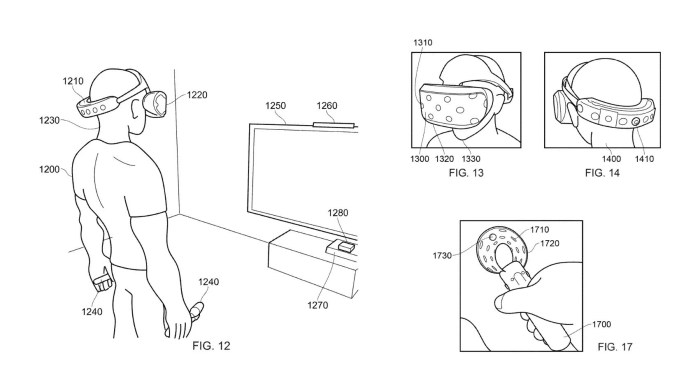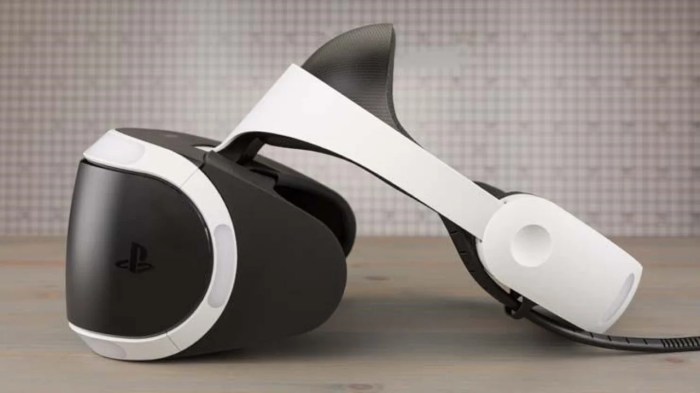Sony Patent Hints at Wireless PSVR Headset: Say goodbye to tangled wires and hello to untethered VR gaming freedom! A newly surfaced Sony patent suggests a revolutionary wireless PSVR headset is on the horizon, promising a significant leap forward in virtual reality experiences. This isn’t just another incremental upgrade; we’re talking about potentially eliminating the biggest hurdle to widespread VR adoption: the cumbersome, restrictive cable.
This patent dives deep into the technical challenges of creating a truly wireless, low-latency VR headset, addressing issues like power management and maintaining a seamless, lag-free connection. The implications are huge, potentially reshaping the VR gaming landscape and influencing the design of future headsets across the industry. Imagine the possibilities: unhindered movement, truly immersive gameplay, and a far more accessible VR experience for everyone.
User Experience and Design
Sony’s patent hinting at a wireless PSVR headset promises a significant leap forward in virtual reality gaming. The elimination of wires alone drastically alters the user experience, paving the way for a more immersive and comfortable VR journey. Let’s delve into the specifics of how this technological advancement could reshape the future of PlayStation VR.
Improved User Experience Through Wireless Technology
The most immediate impact of a wireless PSVR headset is the freedom it offers. No more tripping over cables, no more tangled wires restricting movement, and no more frustrating limitations on play space. This enhanced freedom allows for more natural and intuitive interactions within virtual environments, leading to a more believable and immersive gaming experience. Imagine seamlessly moving around your virtual world without the physical constraints of wires – that’s the transformative power of wireless technology. This is similar to the jump from wired to wireless headphones; the convenience is undeniable.
Comfort and Ergonomics
A wireless design opens up possibilities for improved comfort and ergonomics. Without the weight and pull of cables, the headset can be designed lighter and more balanced. This could involve a more streamlined headstrap design, potentially incorporating advanced materials for better weight distribution and breathability. Think of the difference between wearing a bulky wired headset and a lightweight, comfortable pair of wireless earbuds – that same level of improvement is possible here. The elimination of cable-related discomfort will also contribute to longer, more enjoyable VR sessions.
Visual Fidelity and Latency
While wireless technology might introduce challenges in maintaining high visual fidelity and low latency, Sony’s patent suggests potential solutions. The patent likely addresses minimizing signal interference and optimizing data transmission to ensure a smooth, lag-free VR experience. We can expect advancements in compression algorithms and antenna design to achieve a seamless visual experience comparable to, or even exceeding, the current wired version. For example, advancements in 5G technology and Wi-Fi 6E have already demonstrated significant improvements in low-latency, high-bandwidth wireless communication, paving the way for this improvement in VR.
Design of Future PSVR Headsets, Sony patent hints at wireless psvr headset
The patent’s implications extend beyond mere wireless connectivity. It suggests a more compact and aesthetically pleasing headset design. With the elimination of the cable port and associated wiring, designers have greater freedom to refine the headset’s form factor, potentially leading to a sleeker, more modern look. The internal components might also be re-arranged for better weight distribution and improved ergonomics. Think of the evolution of mobile phones from bulky brick-like devices to the sleek smartphones we have today; this is a similar paradigm shift in headset design.
Hypothetical PSVR Headset Design
Imagine a sleek, lightweight PSVR headset, perhaps crafted from a combination of matte black plastic and soft-touch materials for enhanced comfort. The headstrap is adjustable and features a comfortable, breathable padding. The headset itself is significantly smaller and lighter than its predecessor, minimizing pressure points and fatigue during extended use. The user interface could be streamlined, perhaps utilizing a combination of intuitive haptic feedback and a minimalist on-screen display for vital information like battery life and connection status. A subtle, integrated LED indicator could signal the headset’s power status and connection strength. The overall aesthetic would be minimalist and modern, prioritizing both functionality and style.
Future Implications and Potential Applications: Sony Patent Hints At Wireless Psvr Headset
Sony’s patent hinting at a wireless PSVR headset isn’t just about gaming; it’s a glimpse into a future where virtual reality seamlessly integrates into our everyday lives. This technology has the potential to revolutionize fields beyond entertainment, offering immersive experiences with significant implications for various industries.
This wireless leap represents a significant advancement in VR technology, potentially paving the way for more comfortable, accessible, and versatile VR experiences. Imagine the possibilities – a future where the limitations of wires are a distant memory, replaced by the freedom of untethered movement and immersion. This isn’t just about improved gaming; it’s about unlocking entirely new applications and experiences.
Potential Applications Beyond Gaming
The implications extend far beyond the gaming world. Think about architectural walkthroughs where clients can explore building designs in stunning detail before a single brick is laid. Medical training simulations could become far more realistic and engaging, allowing surgeons to practice complex procedures in a safe, virtual environment. Even remote collaboration could be transformed, with colleagues feeling like they’re in the same room, regardless of their physical location. The possibilities are truly vast, limited only by our imagination and the innovative applications developed.
Integration with Other Sony Products and Services
A wireless PSVR headset could easily integrate with other Sony products and services. Imagine seamless integration with the PlayStation 5, offering a truly immersive gaming experience. Further integration with Sony’s Bravia XR TVs could enhance visual fidelity and create a more cohesive home entertainment ecosystem. Even integration with Sony’s music services could create immersive audio-visual experiences, transforming music listening into a truly engaging sensory experience. The potential for synergistic product development is enormous.
Challenges to Implementation and Commercialization
While the potential is exciting, there are challenges. Developing a wireless headset that delivers the same level of performance and low latency as a wired counterpart is a significant technical hurdle. Battery life will be a crucial consideration, requiring efficient power management solutions to ensure extended playtime. The cost of implementing this advanced technology could also impact the initial price point, potentially limiting accessibility for some consumers. Finally, ensuring seamless compatibility with existing and future PlayStation consoles will be essential for a successful launch. These challenges are not insurmountable, but require careful planning and execution.
Influence on the Evolution of VR Technology
This patent could significantly influence the wider VR landscape. A successful wireless PSVR headset would demonstrate the feasibility and desirability of wireless VR technology, encouraging other manufacturers to invest in similar solutions. This could lead to a broader adoption of VR technology across various industries, accelerating the pace of innovation and potentially driving down costs. The success of this technology will serve as a benchmark for the entire industry.
Potential Timeline for Development and Release
Predicting a precise timeline is difficult, but a plausible scenario could see prototype testing and refinement within the next 1-2 years, followed by an announcement and eventual release sometime between 2025 and 2027. This timeframe allows for thorough testing, optimization, and integration with existing and future Sony platforms. Successful launches of other major VR headsets, such as the Meta Quest 3, will serve as a guide for Sony’s own release strategy. This timeline is, of course, subject to change depending on unforeseen challenges or advancements in technology.
The implications of Sony’s wireless PSVR patent extend far beyond just gaming. This could be a game-changer for VR adoption, making the technology more appealing to a wider audience. While challenges remain in bringing this technology to market, the potential rewards are enormous. A wireless PSVR headset could redefine what’s possible in virtual reality, ushering in a new era of immersive experiences and potentially influencing the development of wireless VR technology across the board. Get ready to ditch the wires – the future of VR is looking wireless.
 Tech Nest Online Berita Teknologi Terbaru
Tech Nest Online Berita Teknologi Terbaru

